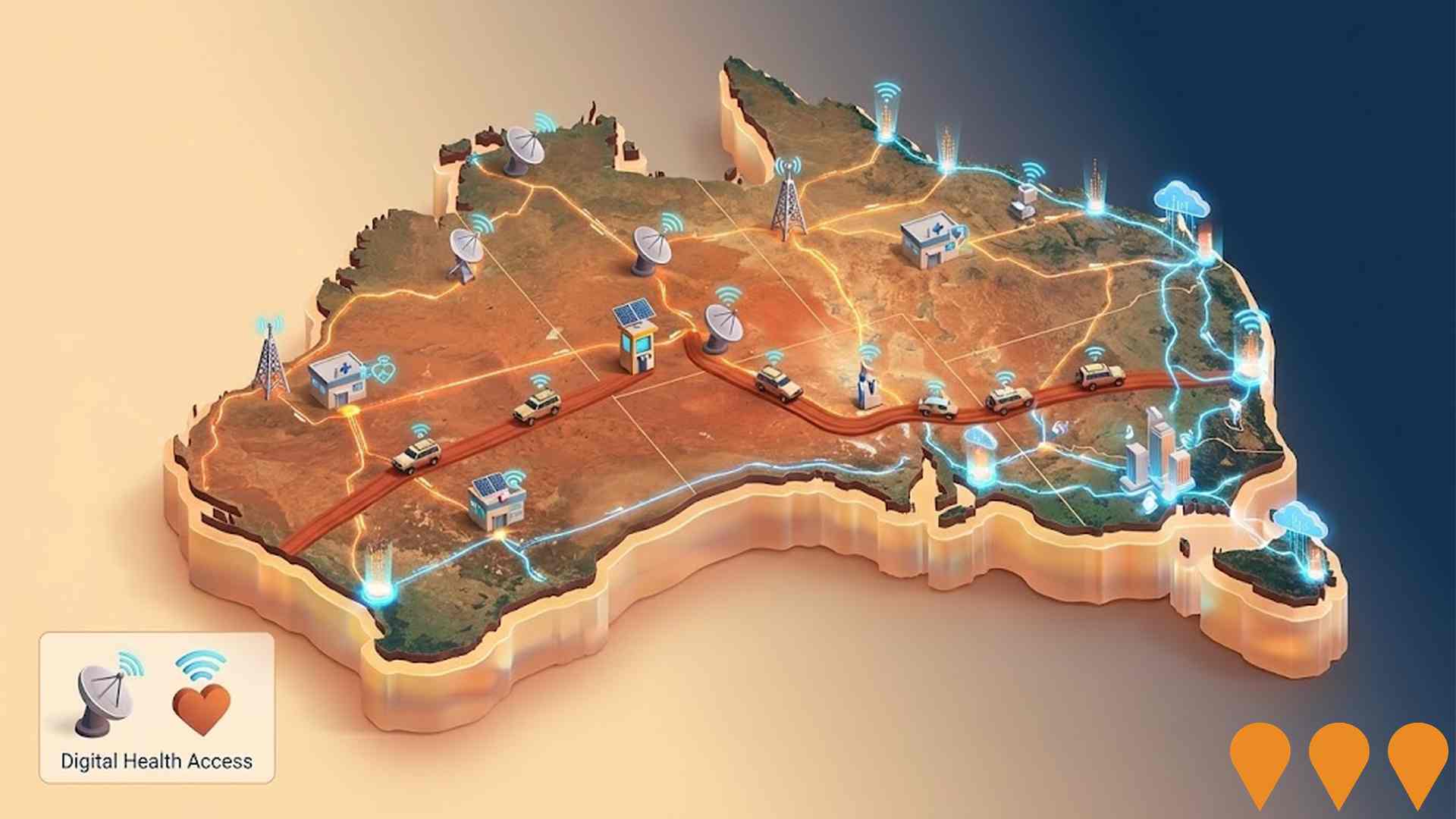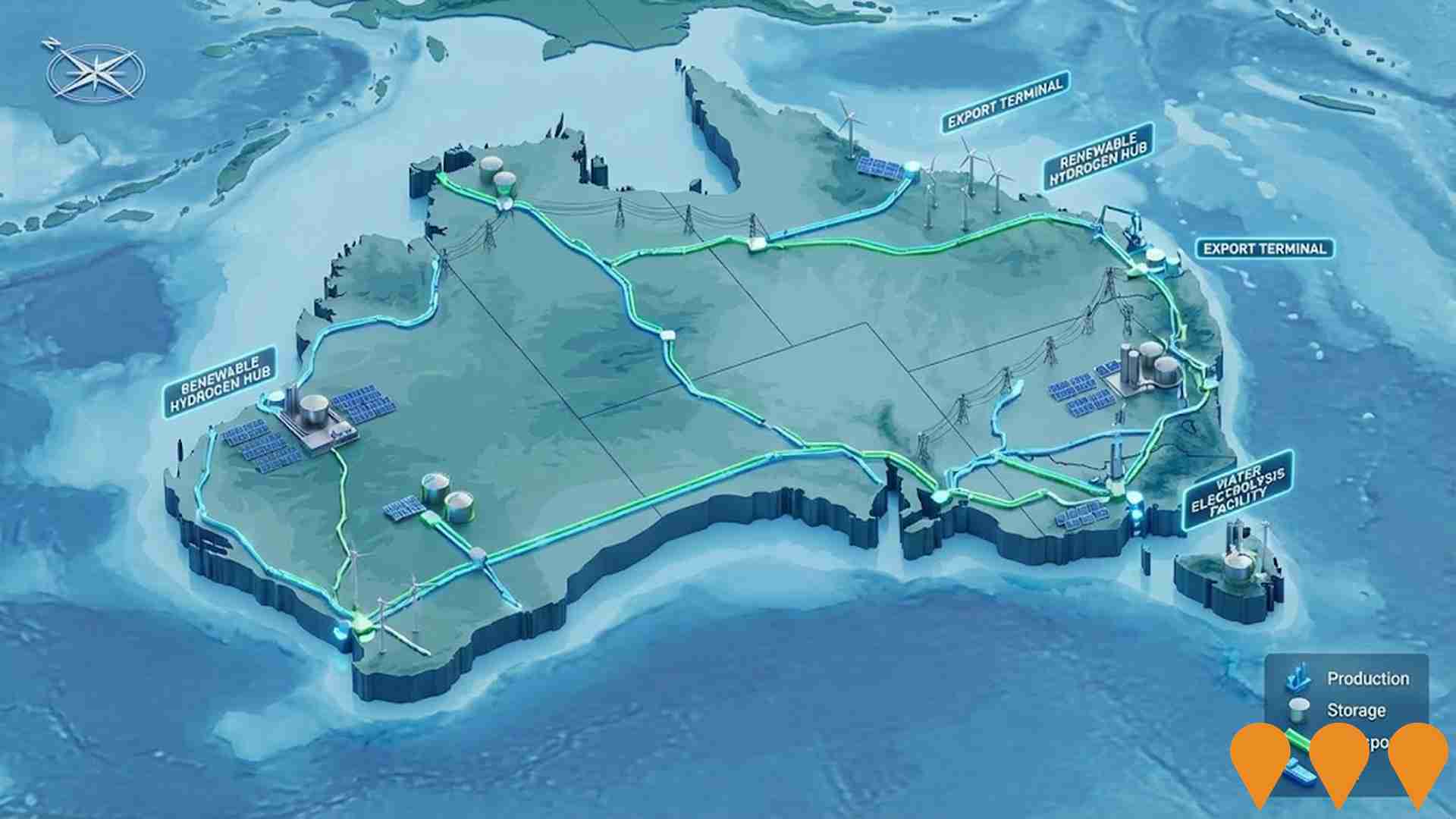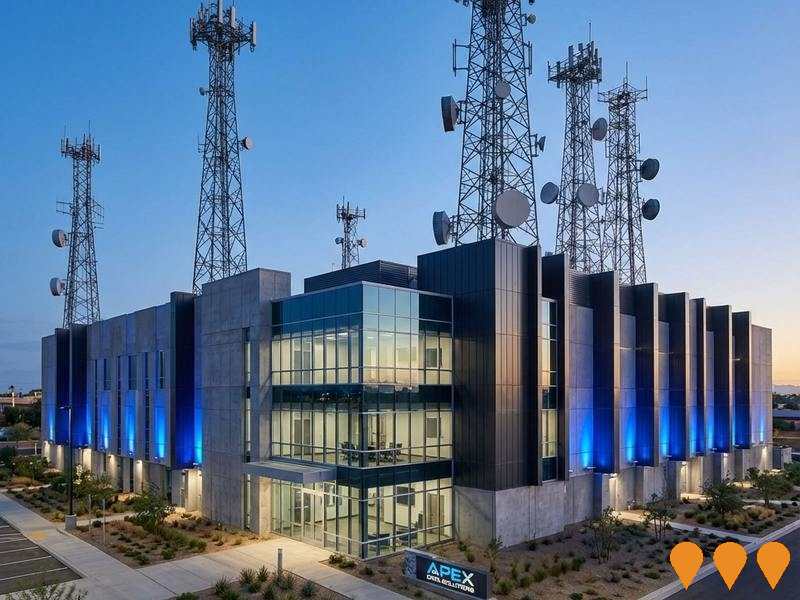Chart Color Schemes
est. as @ -- *
ABS ERP | -- people | --
2021 Census | -- people
Sales Activity
Curious about local property values? Filter the chart to assess the volume and appreciation (including resales) trends and regional comparisons, or scroll to the map below view this information at an individual property level.
Find a Recent Sale
Sales Detail
Population
Anindilyakwa is positioned among the lower quartile of areas assessed nationally for population growth based on AreaSearch's assessment of recent, and medium term trends
Based on AreaSearch's analysis, Anindilyakwa's population was around 2,927 as of Aug 2025. This reflected an increase of 386 people (15.2%) since the 2021 Census, which reported a population of 2,541 people. The change was inferred from the estimated resident population of 2,927 from the ABS as of June 2024 and address validation since the Census date. This level of population equated to a density ratio of 1.1 persons per square kilometer. Anindilyakwa's 15.2% growth since the 2021 census exceeded the national average (8.6%), along with the state, marking it as a growth leader in the region. Population growth for the area was primarily driven by interstate migration that contributed approximately 46.9% of overall population gains during recent periods, although all drivers including overseas migration and natural growth were positive factors.
AreaSearch adopted ABS/Geoscience Australia projections for each SA2 area, as released in 2024 with 2022 as the base year. For any SA2 areas not covered by this data, and to estimate growth across all areas in the years post-2032, AreaSearch applied growth rates by age cohort to each area, as provided by the ABS in its latest Greater Capital Region projections (released in 2023, based on 2022 data). As future population trends were examined, an above median population growth of national regional areas was projected, with the area expected to increase by 395 persons to 2041 based on the latest population numbers, reflecting an increase of 13.5% in total over the 17 years.
Frequently Asked Questions - Population
Development
Residential development activity is lower than average in Anindilyakwa according to AreaSearch's national comparison of local real estate markets
Anindilyakwa experienced limited development activity from 2016 to 2020, with an average of one approval per year, resulting in seven dwellings over the five-year period. This low level reflects its rural nature, where development is driven by specific local housing needs rather than broad market demand. The small number of approvals means individual projects can significantly impact annual growth and relativity statistics.
Anindilyakwa had substantially lower development levels compared to the Rest of NT during this period, with its development pattern also well below national averages. Recent development comprised entirely detached houses, favouring family homes suited for those seeking rural lifestyle and space, despite increasing density pressures. New construction favoured detached housing more than current patterns suggest (84.0% at Census). By 2041, Anindilyakwa is expected to grow by 395 residents.
If current construction levels persist, housing supply may lag population growth, potentially intensifying buyer competition and underpinning price growth.
Frequently Asked Questions - Development
Infrastructure
Anindilyakwa has limited levels of nearby infrastructure activity, ranking in the 2ndth percentile nationally
No local infrastructure changes are currently identified by AreaSearch that may impact this area. Key projects include Australia-Asia PowerLink, Northern Territory Freight Rail And Logistics Capacity Improvements, Network Optimisation Program - Rail, and Enabling Digital Health Services for Regional and Remote Australia.
Professional plan users can use the search below to filter and access additional projects.
INFRASTRUCTURE SEARCH
 Denotes AI-based impression for illustrative purposes only, not to be taken as definitive under any circumstances. Please follow links and conduct other investigations from the project's source for actual imagery. Developers and project owners wishing us to use original imagery please Contact Us and we will do so.
Denotes AI-based impression for illustrative purposes only, not to be taken as definitive under any circumstances. Please follow links and conduct other investigations from the project's source for actual imagery. Developers and project owners wishing us to use original imagery please Contact Us and we will do so.
Frequently Asked Questions - Infrastructure
Enabling Digital Health Services for Regional and Remote Australia
National initiative to expand and improve digital health access for people in regional and remote Australia. Focus areas include enabling telehealth and virtual care, upgrading clinical systems and connectivity, supporting secure information exchange, and building workforce capability in digital health, aligned with the Australian Government's Digital Health Blueprint and Action Plan 2023-2033.

Enabling Infrastructure for Hydrogen Production
Australia has completed the National Hydrogen Infrastructure Assessment (NHIA) to 2050 and refreshed its National Hydrogen Strategy (2024). The programmatic focus has shifted to planning and enabling infrastructure through measures such as ARENA's Hydrogen Headstart and the Hydrogen Production Tax Incentive (from April 2025). Round 2 of Hydrogen Headstart consultation occurred in 2025. Collectively these actions aim to coordinate investment in transport, storage, water and electricity inputs linked to Renewable Energy Zones and priority hubs, supporting large-scale renewable hydrogen production and future export supply chains.

National EV Charging Network (Highway Fast Charging)
Partnership between the Australian Government and NRMA to deliver a backbone EV fast charging network on national highways. Program funds and co-funds 117 DC fast charging sites at roughly 150 km intervals to connect all capital cities and regional routes, reducing range anxiety and supporting EV uptake.

Bulk Water Supply Security
Nationwide program led by the National Water Grid Authority to improve bulk water security and reliability for non-potable and productive uses. Activities include strategic planning, science and business cases, and funding of state and territory projects such as storages, pipelines, dam upgrades, recycled water and efficiency upgrades to build drought resilience and support regional communities, industry and the environment.

Network Optimisation Program - Roads
A national program concept focused on improving congestion and reliability on urban road networks by using low-cost operational measures and technology (e.g., signal timing, intersection treatments, incident management) to optimise existing capacity across major city corridors.

Australia-Asia PowerLink
The Australia-Asia PowerLink (AAPowerLink) is SunCable's flagship renewable generation and transmission project that will harness Northern Territory's world-class solar energy potential for 24/7 transmission to Darwin and Singapore. The project includes development of the world's largest integrated renewable energy zone on a 12,000-hectare site at Powell Creek, featuring 17-20GW of solar capacity and 36-42GWh of battery storage. It will supply up to 4GW of renewable electricity to Darwin via an 800km HVDC overhead transmission line, and up to 2GW to Singapore through 4,300km of subsea cables. The $30+ billion project will create 1,750 direct construction jobs, 350 operational jobs, and up to 12,000 indirect jobs, while supporting Australia's transition to renewable energy and establishing new export opportunities to Southeast Asia.

Northern Territory Freight Rail And Logistics Capacity Improvements
Improvements to the Darwin-Tarcoola rail line in the Northern Territory aim to support $38 billion in investments, 6,000+ jobs, and the export of resources and renewable energy by enhancing freight logistics.

Network Optimisation Program - Rail
A proposal to address urban and regional rail network capacity constraints in Australia through data and technology, aiming to improve efficiency and delay the need for larger-scale investments.

Employment
Employment conditions in Anindilyakwa face significant challenges, ranking among the bottom 10% of areas assessed nationally
Anindilyakwa has a balanced workforce comprising white and blue-collar jobs. Key sectors include essential services.
The unemployment rate is 7.6%. As of June 2025, there are 1,307 employed residents with an unemployment rate at 9.6%, above the Rest of NT's rate of 5.9%. Workforce participation stands at 42.1% compared to Rest of NT's 50.7%. Employment is concentrated in mining (8.6 times regional level), public administration & safety, and education & training.
Health care & social assistance employs 10.0%, below the Rest of NT's 18.8%. The worker-to-resident ratio is 0.7, indicating higher-than-average local employment opportunities. Between June 2024 and June 2025, the labour force decreased by 1.7% while employment declined by 1.1%, reducing unemployment by 0.6 percentage points. In contrast, Rest of NT saw employment contract by 1.7%. Jobs and Skills Australia's forecasts from May 2025 project national employment growth of 6.6% over five years and 13.7% over ten years. Applying these projections to Anindilyakwa's employment mix suggests local growth of approximately 5.0%% over five years and 11.5% over ten years, assuming constant population projections for illustrative purposes.
Frequently Asked Questions - Employment
Income
The area's income profile falls below national averages based on AreaSearch analysis
AreaSearch's latest postcode level ATO data for financial year ended June 2022 shows that income in Anindilyakwa is approximately average nationally, with a median assessed at $49,407 and an average income of $64,464. This contrasts with the Rest of NT's figures, which have a median income of $51,655 and an average income of $61,577. Based on Wage Price Index growth of 12.01% from July 2022 to September 2025, current estimates would be approximately $55,341 (median) and $72,206 (average). According to the Census conducted in August 2021, individual incomes at the 1st percentile are $336 weekly, while household income is at the 41st percentile. Income analysis shows that the $1,500 - 2,999 earnings band captures 27.9% of the community (816 individuals), which aligns with regional levels where this cohort represents 33.6%. After housing costs, residents retain 95.1% of their income, indicating strong purchasing power.
Frequently Asked Questions - Income
Housing
Anindilyakwa is characterized by a predominantly suburban housing profile, with a higher proportion of rental properties than the broader region
The latest Census evaluation showed that dwelling structures in Anindilyakwa consisted of 83.9% houses and 16.1% other dwellings (semi-detached, apartments, 'other' dwellings). In comparison, Non-Metro NT had 89.4% houses and 10.5% other dwellings. Home ownership in Anindilyakwa was at 1.5%, with the rest being mortgaged (0%) or rented (98.5%). The median monthly mortgage repayment in Anindilyakwa was $1,083, lower than Non-Metro NT's average of $1,664. The median weekly rent figure for Anindilyakwa was recorded at $80, matching Non-Metro NT's figure. Nationally, Anindilyakwa's mortgage repayments were significantly lower than the Australian average of $1,863, while rents were substantially below the national figure of $375.
Frequently Asked Questions - Housing
Household Composition
Anindilyakwa features high concentrations of family households, with a lower-than-average median household size
Family households account for 83.6% of all households, including 46.2% couples with children, 19.6% couples without children, and 15.2% single parent families. Non-family households make up the remaining 16.4%, consisting of 15.0% lone person households and 0.9% group households. The median household size is 3.7 people, which is smaller than the Rest of NT average of 4.0.
Frequently Asked Questions - Households
Local Schools & Education
Anindilyakwa faces educational challenges, with performance metrics placing it in the bottom quartile of areas assessed nationally
The area faces educational challenges, with university qualification rates at 13.8%, significantly below the Australian average of 30.4%. This presents both a challenge and an opportunity for targeted educational initiatives. Bachelor degrees are most common at 9.1%, followed by postgraduate qualifications (3.1%) and graduate diplomas (1.6%). Trade and technical skills are prominent, with 29.3% of residents aged 15+ holding vocational credentials - advanced diplomas (6.0%) and certificates (23.3%).
Educational participation is high, with 32.1% of residents currently enrolled in formal education, including 19.0% in primary, 5.4% in secondary, and 2.1% pursuing tertiary education. Anindilyakwa's 5 schools have a combined enrollment of 317 students as of the latest data. The area shows varied educational conditions across Anindilyakwa, with an educational mix including 1 primary school and 4 K-12 schools. School places per 100 residents stand at 10.8, below the regional average of 18.0, indicating some students may attend schools in adjacent areas. Note: for schools showing 'n/a' in enrolments, please refer to their parent campus.
Frequently Asked Questions - Education
Schools Detail
Nearby Services & Amenities
Transport
No public transport data available for this catchment area.
Frequently Asked Questions - Transport
Transport Stops Detail
Health
Anindilyakwa's residents boast exceedingly positive health performance metrics with both young and old age cohorts seeing low prevalence of common health conditions
Anindilyakwa's health outcomes data shows significant results with both younger and older age groups having low prevalence rates for common health conditions.
The private health cover rate is approximately 52%, higher than the average SA2 area (~1,519 people). Heart disease and diabetes are the most prevalent medical conditions in the region, affecting 4.6% and 3.5% of residents respectively. A total of 84.4% of residents report being completely free from medical ailments, compared to 82.9% across the Rest of NT. The area has a lower percentage of residents aged 65 and over at 3.3% (96 people) compared to the Rest of NT's 5.0%. Despite this, health outcomes among seniors require more attention than those in the broader population.
Frequently Asked Questions - Health
Cultural Diversity
The level of cultural diversity witnessed in Anindilyakwa was found to be above average when compared nationally for a number of language and cultural background related metrics
Anindilyakwa's population shows above-average cultural diversity, with 6.9% born overseas and 70.0% speaking a language other than English at home. Christianity is the dominant religion, comprising 42.9%. However, 'Other' religions make up only 7.9%, lower than the Rest of NT average of 15.8%.
In terms of ancestry, Australian Aboriginal is highest at 61.2%, followed by Australian at 12.9% and English at 9.3%. Some ethnic groups have notable variations: Maori is overrepresented at 0.7% (vs regional 0.7%), Samoan at 0.2% (vs none), and South African at 0.4% (vs regional 0.3%).
Frequently Asked Questions - Diversity
Age
Anindilyakwa hosts a very young demographic, ranking in the bottom 10% of areas nationwide
Anindilyakwa's median age of 30 years is close to the Rest of NT's 31 years and significantly lower than Australia's national average of 38 years. Compared to the Rest of NT, Anindilyakwa has a higher percentage of residents aged 35-44 (18.8%) but fewer residents aged 65-74 (3.0%). Between the 2016 and 2021 censuses, the age group of 35 to 44 increased from 17.0% to 18.8%, while the 55 to 64 cohort rose from 8.4% to 9.6%. Conversely, the 0 to 4 age group decreased from 8.6% to 5.6%, and the 15 to 24 age group fell from 18.0% to 15.6%. By 2041, demographic modeling suggests Anindilyakwa's age profile will change significantly. The 25 to 34 age group is projected to grow by 23%, reaching 698 people from 565. However, both the 85+ and 15 to 24 age groups are expected to decrease in number.

